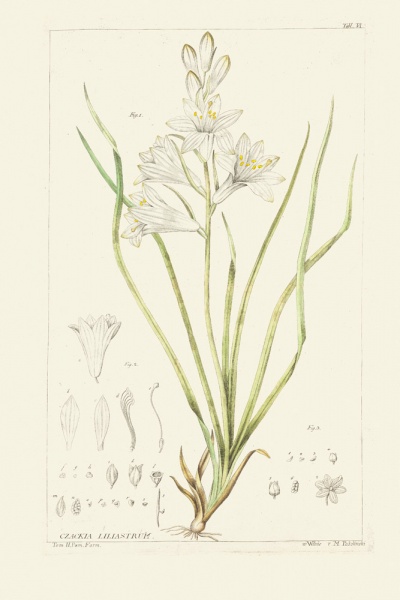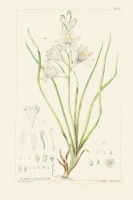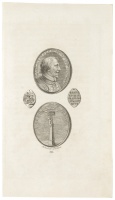PAMIĘTNIK FARMACEUTYCZNY WILENSKI, T. 2, WILNO, 1822.
In the early 19th century, artists, especially those connected with Vilnius University, received frequent invitations to illustrate scientific publications. This practice sought in part to reinforce the practical effectiveness of study programmes in art, especially those by the Department of Graphic Art. The engraving Czackia liliastrum is a perfect example of the collaboration between science and art.
The staff of Vilnius University and the Kremenets Lyceum carried out extensive botanical research into the flora of the Polish Lithuanian state in the early 19th century. The botanist Antoni Andrzejewski (1785–1868) of the Kremenets Lyceum, in his first botanical study printed in 1818, described a very rare plant of the Asparagaceae family, Anthericum liliastrum, which was found in Poland. The botanist named the plant Czackia liliastrum in honour of Tadeusz Czacki (1765–1813), the founder and patron of the Kremenets Lyceum, and his service to science and education. This engraving was printed in the second volume of Pamiętnik farmaceutyczny Wilenski (Diary of Vilnius Pharmacy), the magazine of the Pharmacy Section of the Vilnius Medical Society, published by the Vilnius University pharmacy professor Johann Friedrich Wolfgan. The artist was one of the most famous teachers on the staff of the Department of Graphic Art. The engraving might have been based on an example provided by A. Andrzejewski. The drawing conveys the shape of the plant in graceful lines and is aesthetically pleasing.
It is possible that the attention that botanists paid to the local flora encouraged artists to look closer at the natural world.
Text author Rūta Janonienė
Source: Law firm Valiunas Ellex art album
RES PUBLICA (2018). Compiler and author Rūta Janonienė

PAMIĘTNIK FARMACEUTYCZNY WILENSKI, T. 2, WILNO, 1822












